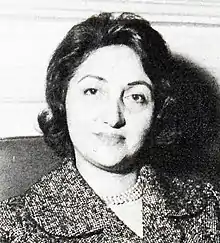Mehrangiz Dowlatshahi
Mehrangiz Dowlatshahi (Persian: مهرانگیز دولتشاهی; 13 December 1919 – 11 October 2008) was an Iranian social activist and politician, who held significant positions, including ambassador of Iran to Denmark during the Pahlavi era. She also served as a member of the Majlis for three terms.
Mehrangiz Dowlatshahi | |
|---|---|
 | |
| Iranian Ambassador to the Denmark | |
| In office 1 March 1975 – 1 March 1979 | |
| Preceded by | Parviz Sepahboudi |
| Succeeded by | Abbas Amir-Entezam |
| Member of the Parliament of Iran | |
| In office 15 January 1963 – 14 January 1975 | |
| Constituency | Kermanshah |
| Personal details | |
| Born | 13 December 1919 Isfahan, Qajar Iran |
| Died | 1 October 2008 (aged 88) Paris, France |
| Political party |
|
| Parents |
|
| Alma mater | |
Early life and education
Her family were major land owners based in Kermanshah[1] and were progressive aristocrats.[2] Her father was Mohammad Ali Mirza (also known as Meshkout Al Dowleh), majlis member and land owner.[3][4] He was a member of the Qajar dynasty.[5] Her mother was Akhtar ol-Mulk, daughter of Hidayat Quli Khan. Mehrangiz was the cousin of Esmat Dowlatshahi, fourth wife of Reza Shah.[6]
Concerning the birth date and birthplace of Dowlatshahi there are some conflicting reports which were stated by herself.[5] Abbas Milani states that she gave two different birth years, 1917 and 1919.[5] The same is also reported by Abbas Milani in regard to her birth city, which was given as both Tehran and Isfahan.[5]
Mehrangiz was one of the first Iranian girls who attended a co-education kindergarten.[2] Then she graduated from the Zoroastrian School in Tehran.[2] She held a bachelor's degree from Berlin University.[3] She received a PhD in social and political sciences from Heidelberg University.[3]
Career
Dowlatshahi worked at the social services organization and at the organization for support of prisoners.[7] She established Jama’at-i Rah-i Naw (Persian: The New Path Society) in 1954, which later became part of the International Women's Syndicate.[7][8] The society offered training to women and advocated equal rights for them.[3] She also launched adult literacy programs in southern Tehran.[7] In 1951, she and activist Safeyeh Firouz met Mohammad Reza Shah to discuss the electoral rights of women in Iran.[9] She was the director of the advisory committee on international affairs of the Women's Organization of Iran (WOI).[10] In 1973, she was appointed president of the International Council of Women and her term ended in 1976.[11]
She was elected to the Majlis in 1963, being one of six female deputies.[12] She served there until 1975.[10] She represented Kermanshah at the Majlis for three terms.[13] She significantly contributed to the passing of the family protection law in 1967 and to its expansion in 1974.[13] She also served as the first minister of women affairs.[14] She was also the first woman ambassador of Imperial Iran to Denmark.[14] She was appointed to the post in 1975.[15]
Later years and death
Dowlatshahi was serving as the Iranian ambassador in Denmark when the 1979 revolution occurred. Soon after this incident she left the country and settled in Paris.[7] In 2002, she published a book entitled Society, Government, and Iran’s Women’s Movement.[7] She died in Paris in October 2008.[7]
Awards and honors
 Grand Cross of the Order of the Dannebrog (Denmark; 14 February 1979)
Grand Cross of the Order of the Dannebrog (Denmark; 14 February 1979)
In 1997, Dowlatshahi was named as the woman of the year by the Iranian Women's Studies Foundation in the United States.[16]
References
- "Centers of Power in Iran" (PDF). CIA. May 1972. Retrieved 5 August 2013.
- Camron Michael Amin (1999). "Propaganda and remembrance: gender, education, and "the women's awakening" of 1936". Iranian Studies. 32 (3): 371. doi:10.1080/00210869908701961. PMID 21879513.
- "Sex equality still elusive: feminist". The Age. 6 November 1973. Retrieved 30 July 2013.
- "Dolatshahi, Mehrangiz". Harvard University. Archived from the original on 22 February 2018. Retrieved 30 July 2013.
- Abbas Milani (2008). Eminent Persians: The Men and Women Who Made Modern Iran, 1941-1979. Syracuse, NY: Syracuse University Press. p. 526. ISBN 978-0-8156-0907-0.
- Camron Michael Amin (2002). The Making of the Modern Iranian Woman: Gender, State Policy, and Popular Culture, 1865-1946. Gainesville, FL: University Press of Florida. p. 115. ISBN 978-0-8130-3126-2.
- Nazy Kaviani (28 October 2008). "Mehrangiz Dolatshahi". Iranian. Archived from the original on 5 December 2013. Retrieved 30 July 2013.
- Mana Kia (2005). "Negotiating Women's Rights: Activism, Class, and Modernization in Pahlavi Iran". Comparative Studies of South Asia, Africa and the Middle East. 25 (1): 233. doi:10.1215/1089201X-25-1-227.
- Ali Akbar Mahdi (October 2004). "The Iranian Women's Movement: A Century Long Struggle". The Muslim World. 94 (4): 427–448. doi:10.1111/j.1478-1913.2004.00067.x.
- "Oral History interview of Mehrangiz Dowlatshahi". Foundation for Iranian Studies. Bethesda, MD. Archived from the original on 24 March 2010. Retrieved 30 July 2013.
- "About us". International Council of Women. Archived from the original on 9 September 2013. Retrieved 30 July 2013.
- Hamideh Sedghi (2007). Women and Politics in Iran: Veiling, Unveiling, and Reveiling. Cambridge: Cambridge University Press. p. 159. doi:10.1017/CBO9780511510380. ISBN 9780511510380.
- "Mehrangiz Dolatshahi, who struggled for the ratification of the "Family Support Law" in 1967". The Feminist School. 23 October 2008. Archived from the original on 6 May 2021. Retrieved 30 July 2013.
- Darius Kadivar (6 September 2010). "Mehrangiz Dolatshahi First Woman Ambassador of Imperial Iran (1960)". Iranian. Retrieved 30 July 2013.
- Official Report of Debates. Vol. II. Strasbourg: Council of Europe. 1980. p. 681. GGKEY:49S8UY2XXFL.
- "The Woman of the Year. Past awardees". IWSF. Archived from the original on 12 July 2013. Retrieved 30 July 2013.
External links
 Media related to Mehrangiz Dolatshahi at Wikimedia Commons
Media related to Mehrangiz Dolatshahi at Wikimedia Commons